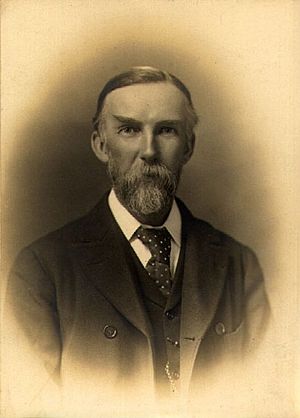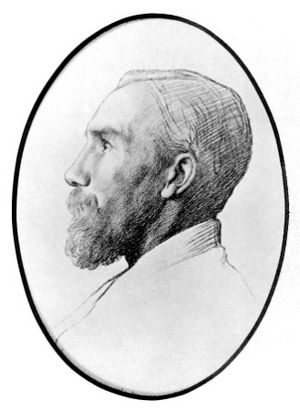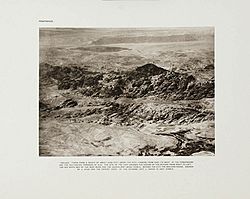Alexander Kennedy facts for kids
Quick facts for kids
Sir Alexander Kennedy
|
|
|---|---|
 |
|
| Born |
Alexander Blackie William Kennedy
17 March 1847 |
| Died | 1 November 1928 (aged 81) |
| Nationality | British |
| Education | City of London School and the Royal School of Mines |
| Occupation | Engineer |
| Engineering career | |
| Discipline | Civil, Electrical |
| Institutions | Institution of Civil Engineers (president), Institution of Mechanical Engineers (president), Royal Society (fellow), Institution of Electrical Engineers (member), Physical Society of London (council member), British Association for the Advancement of Science (president of engineering) |
Sir Alexander Blackie William Kennedy (born March 17, 1847 – died November 1, 1928) was a very important British civil and electrical engineer. He was also a professor and a keen mountaineer. He loved photography and was one of the first to take pictures of the ancient city of Petra in Jordan.
Contents
Early Life and Engineering Start
Alexander Kennedy was born in Stepney, London. His parents, John Kennedy and Helen Stodart Blackie, were from Aberdeen, Scotland. He went to the City of London School. Later, he took a short course at the Royal School of Mines to learn the basics of engineering.
In 1864, when he was 17, he started an apprenticeship at a shipbuilding company called J & W Dudgeon. He worked there for four years as a draughtsman, which is someone who draws detailed plans. He helped build some of the first ships with new types of engines and twin propellers. By the time he left, he understood these new systems very well.
After his apprenticeship, he joined Palmers' Engine Works in Jarrow. There, he became the main draughtsman and designed the first compound engine built in the north of England. He also worked for a short time as a chief draughtsman for T.M. Tennant and Company.
Becoming a Partner
In 1871, at just 24 years old, Alexander was invited to become a partner with H.O. Bennett in Edinburgh. For the next three years, he worked a lot on designing, building, and testing boilers. In 1873, he visited the Vienna Exhibition. He studied the boiler and engine designs shown there. He wrote articles about them for the Engineering journal. These articles were later used in the official report on the exhibition.
Changing Engineering Education
In 1874, when he was only 27, Alexander Kennedy became a professor of Engineering at University College, London (UCL). He stayed in this job for 15 years. He made big changes to how engineering was taught around the world.
He believed that students needed more than just lectures. He made sure his students also learned a lot about mathematics, physics, chemistry, and geology. These are the basic sciences that engineering relies on. He also asked for an engineering laboratory to be built. This way, students could get hands-on experience with what they learned in class.
Many engineers supported his idea. In 1878, the laboratory was built and used. It was the first of its kind in the world! It was so helpful that over the next nine years, ten other schools built their own engineering labs, following his example.
While at UCL, he also translated a German book about how machines move into English. He also did many experiments in his lab. He studied the strength and elasticity of different materials. For this important work, he was made a fellow of the Royal Society in 1887. He also looked into the strength of riveted joints and new electric turbines.
Engineering Consultant
Kennedy also had a busy side business as a consultant. He designed many things, like a steel pier in France and parts of famous buildings in London, such as the Alhambra Theatre and the first Hotel Cecil. He used his laboratory to test his materials. His designs were always trusted because he put so much research into them.
Once, he was asked to check out a remote oil area in California. It was several days away by horse from the nearest road. Kennedy had never ridden a horse before! But he took the job and started taking riding lessons every morning before his lectures. He quickly became a good rider. His trip to California was a big success for him and the oil field owners.
Leading Electrical Engineer
In 1889, Kennedy left his professor job at UCL. He decided to focus on electrical engineering, which he had already started researching. He opened his own consulting firm in Westminster with Bernard Maxwell Jenkin. The company was called Kennedy & Jenkin.
His firm quickly became famous for its electrical work. His first big job was to design the power system for the Westminster Electric Supply Corporation. He stayed their main consultant for the rest of his life. He also worked for other electric companies. Many towns got their first electric power stations thanks to his designs. These included Edinburgh, Glasgow, Manchester, Belfast, and York.
Kennedy also built two hydroelectric power stations for the British Aluminium Company. One was at the Falls of Foyers in 1896, and another at Kinlochleven in 1909.
He also advised several railway companies in London. He helped them with electrifying their lines and building tram systems. He suggested using special underground conduits for the electricity supply of London's trams. In 1896, he designed the electrical systems for the Waterloo and City Railway.
In 1900, the British Navy (called The Admiralty) asked Kennedy to join a committee. They wanted him to investigate French-designed boilers being used on ships. This was the first of many jobs he did for the Admiralty. During World War I, he worked behind the front lines in France.
He served on many important committees during the war. He helped with gun sights, rangefinders, and anti-aircraft defenses. After the war, he became chairman of a committee that advised on electric railways for the Ministry of Transport.
Photography, Mountains, and Ancient Cities
Kennedy was a member of The Camera Club and was its president in 1890. During World War I, he visited the Western Front in France. He took many photographs of the war's effects. He later published these pictures in his book, Ypres to Verdun, in 1921.
He loved mountaineering, especially in the Alps mountains. He was a member of the Alpine Club. He even used his first speech as president of the Institution of Civil Engineers to talk about how engineering affects the environment. He also helped update a book about the Alps, adding his own photos of the area.
In 1922, when he was 75, he visited the ancient ruins of Petra in Jordan. It had become safer to visit after the First World War. As an engineer, he was fascinated by the ruins. He returned the next year as a guest of Emir Abdullah, the ruler. He went back a third and final time in 1924. The Emir even gave him the title of Pasha, which was a high honor. These trips were tiring for him, so he decided not to visit again. He wrote a book about the history of Petra, called Petra: its history and monuments, published in 1925.
Personal Life
Alexander Kennedy married Elizabeth Verralls Smith in Scotland on September 8, 1874. They had one daughter, Elizabeth Helen, and two sons, William Smith and John MacFarlane. His younger son, John MacFarlane, became a full partner in his father's engineering firm, Kennedy & Jenkin, in 1908. Alexander's wife died in 1911. He passed away at his home in London on November 1, 1928.
UCL Kennedy Chair in Mechanical Engineering
University College London (UCL) named a special professorship in Kennedy's honor. This position is called the Kennedy Chair. It is now the title for UCL's Professor of Mechanical Engineering.
Some of the professors who have held the Kennedy Chair include:
- Ernest George Coker (1914–1934)
- Richard Evelyn Donohue Bishop (1957–1981)
- Yiannis Ventikos (since 2013)
Societies and Institutions
Alexander Kennedy was a member of many important groups:
- 1878 – Member of the Physical Society of London
- 1879 – Member of the Institution of Civil Engineers
- 1879 – Member of the Institution of Mechanical Engineers
- 1887 – Fellow of the Royal Society
- 1890 – President of The Camera Club
- 1890 – Member of the Institution of Electrical Engineers
- 1894 – President of the engineering section of the British Association
- 1894 – President of the Institution of Mechanical Engineers
- 1907 – President of the Institution of Civil Engineers
Honorary Awards
Kennedy received several special awards and degrees:
- Doctor of Laws from Glasgow University
- Doctor of Laws from Birmingham University
- Doctor of Engineering from Liverpool University
- Fellow of the Royal Society of Edinburgh
- Fellow of the Royal Society of New South Wales



